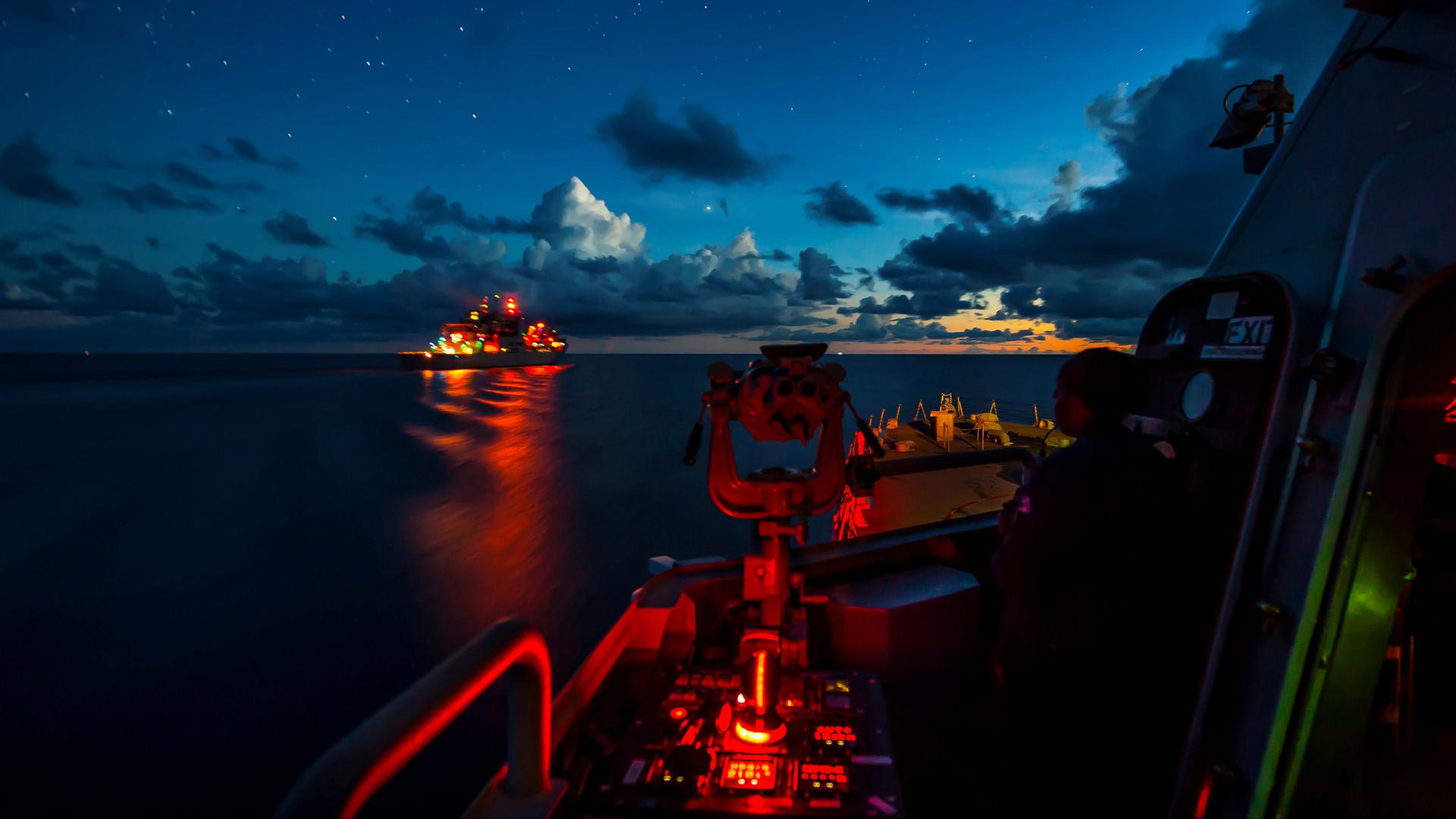The littoral combat ship USS Fort Worth (LCS 3) prepares to transit alongside the Military Sealift Command dry cargo and ammunition ship USNS Wally Schirra (T-AKE 8) during a replenishment-at-sea during routine patrols in international waters of the South China Sea near the Spratly Islands, May 9, 2015.
Recent visitors to the bay surrounding a submarine base on the southern coast of China’s Hainan Island describe a curious nocturnal phenomenon. Powerful spotlights are sometimes trained directly on the ocean frontages of neighboring hotels at night, making visibility out to sea virtually impossible. Some of the lights are mounted on land and others on passing naval patrol boats.
“The effect is incredible,” said one recent visitor. “The glare is so great you can hardly stand it on the balcony. You go inside and draw the curtains tight.”
The blinding lights cannot obscure something of intense interest to the world’s military intelligence agencies: Evidence that China has made a breakthrough in its drive to rival America and Russia as a nuclear arms power.
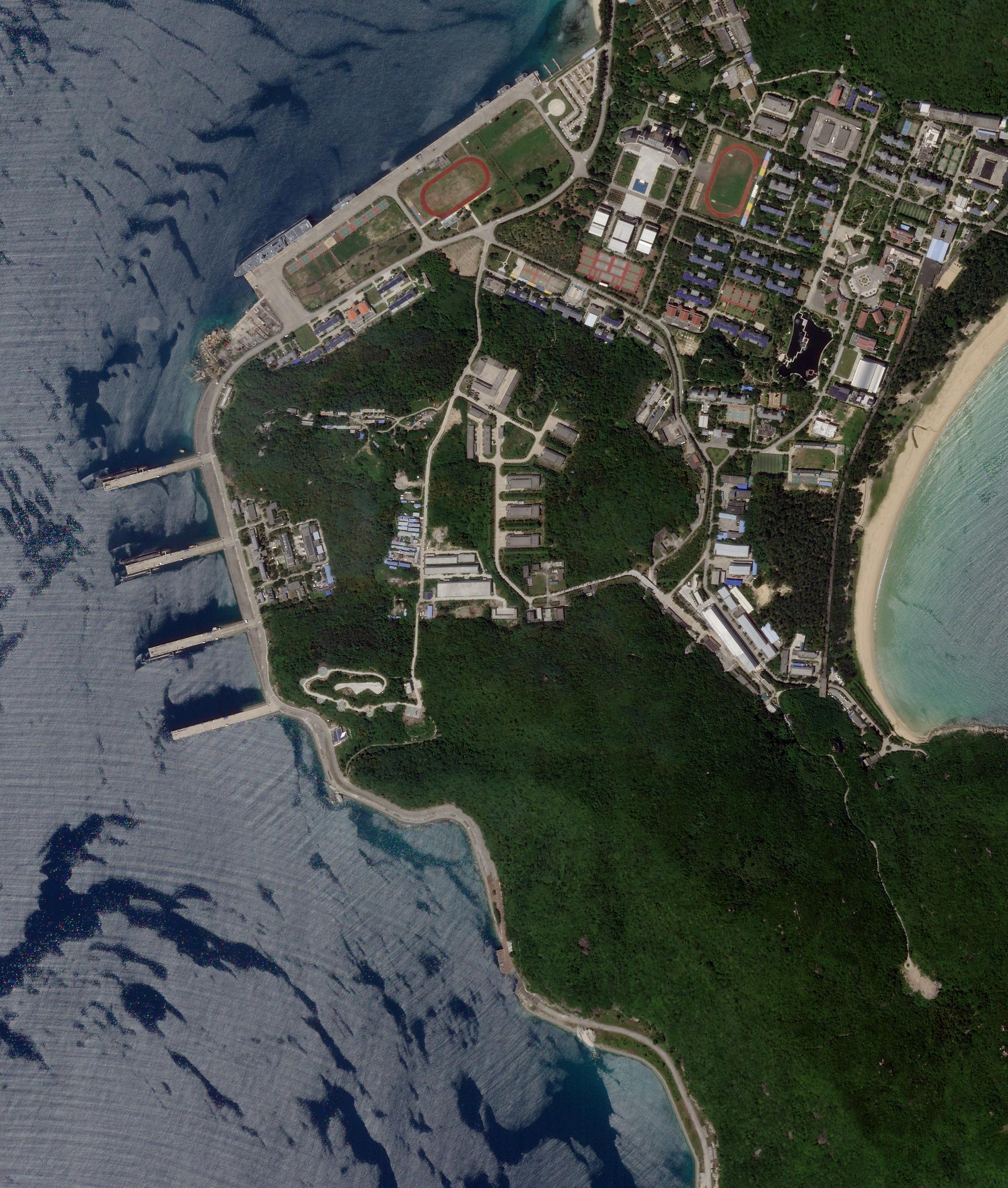
Satellite imagery reveals the regular presence of nuclear-powered ballistic missile submarines at the strategic base near the resort city of Sanya. Specialized surface warships and aircraft designed to protect the subs are prowling key waterways off the coast. Facilities at the base appear to have been built to store and load ballistic missiles. Antenna arrays that support the hunt for foreign submarines have appeared on Chinese-held islands in the hotly contested South China Sea. And a veteran submariner has been appointed to command Chinese forces in the south of the country.
Related: Chinese-US tensions in South China sea put Philippines at risk
Taken together, this means China has a force of missile submarines that can launch nuclear attacks from beneath the waves and now appear to be heading out on patrols, according to serving and retired naval officers, diplomats and security analysts. That gives Beijing something it has until recently lacked: a more reliable “second strike” capability if its land-based nuclear arsenal comes under attack.
After six decades of battling to master complex and challenging subsea military technologies, China has joined the United States, Russia, the United Kingdom and France in the nuclear ballistic missile submarine club. In its most explicit assessment so far of this Chinese capability, the Pentagon in its latest annual report on China’s military, published in August, said that Beijing now has a “credible” and “viable” sea-based nuclear deterrent.
An effective fleet of nuclear ballistic missile submarines, known as SSBNs, marks a dramatic boost to China’s nuclear capabilities. Each of China’s four Jin-class submarines is armed with up to 12 ballistic missiles that can carry a nuclear warhead with an estimated range of 7,200 kilometers (about 4,500 miles), according to the Pentagon. That would put the United States within striking distance from the Western Pacific. Analysts at the Washington-based Center for Strategic and International Studies estimate these missiles could fly at least 8,000 kilometers. The US believes China has up to 100 nuclear missiles based on land.
Related: The trade war between the US and China comes with a cost
Beijing’s enhanced nuclear capability is one of the hallmarks of Chinese leader Xi Jinping’s ambitious revamping of the People’s Liberation Army (PLA), the world’s largest fighting force. China’s nuclear submarine fleet, Western strategists say, has added to the challenge that the increasingly powerful Chinese military poses to US dominance in Asia.
“The opposing side can never be exactly sure that it knows where all of the submarines are,” said Peter Horobin, a retired Australian submarine commander and veteran of the Cold War battles to detect and monitor Soviet subs.
China’s Ministry of National Defense, the US Indo-Pacific Command and the Pentagon did not respond to questions from Reuters.
It is still unclear if the Chinese are deploying fully armed submarines to maintain a round-the-clock deterrent, as the other ballistic missile submarine powers do. Some analysts doubt China has advanced that far.
But the United States and its allies are behaving as if China has. Western military officials say privately that in operational terms, America and its allies — including Japan, Australia and the United Kingdom — are already attempting to track the movements of China’s missile submarines as if they are fully armed and on deterrence patrols.
Asked about their role in tracking Chinese subs, Japan and the United Kingdom said they don’t comment on operational details.
“China’s military modernization is consistent with its rapid economic growth,” the Australian Department of Defense said. “As with all countries, we encourage China to be transparent about its military capabilities and strategic intentions to provide greater assurance to its neighbors.”
Growing stockpile
“An armed Jin-class SSBN will give China an important strategic capability that must be countered,” Admiral Harry Harris, then head of the US Pacific Command, told a congressional committee last year.
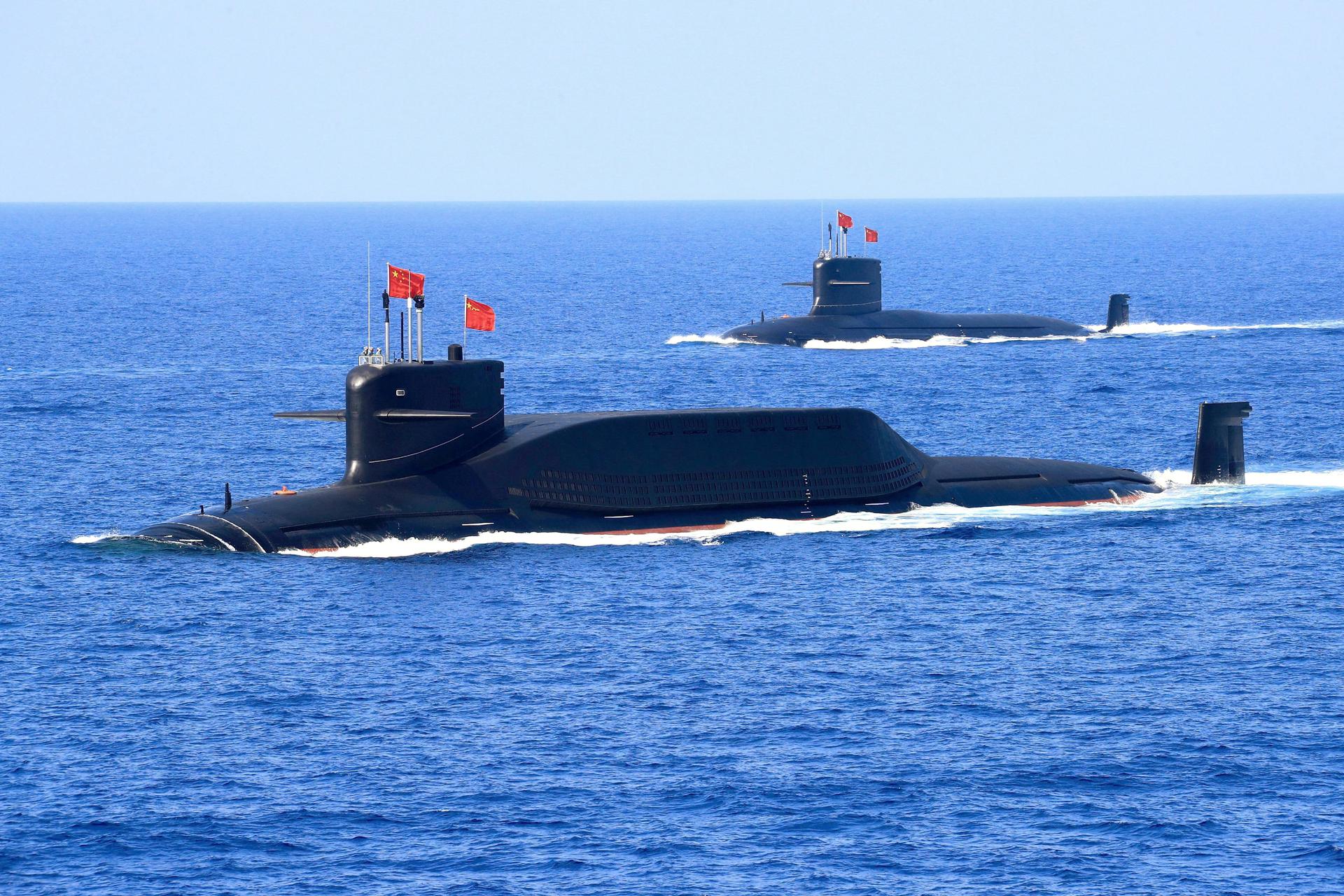
That response appears to be happening. The United States and its allies are expanding their anti-submarine naval deployments across East Asia. This includes stepped-up patrols of America’s advanced, sub-hunting P-8 Poseidon planes out of Singapore and Japan.
With its relatively small force of nuclear missiles, Beijing has always worried that it might be vulnerable to a debilitating first strike. These fears were magnified as Chinese military planners watched Washington employ precision-guided weapons in conflicts like the Gulf wars, Afghanistan, Syria and the Balkans.
Related: A guide to the ‘horrific’ consequences of a US-China naval war
As it strengthens and improves its nuclear arsenal, Beijing is the only major nuclear power to be adding warheads to its stockpiles. China is developing an air-launched ballistic missile and plans to build a long-range stealth bomber capable of carrying nuclear weapons. With the sea-based second-strike deterrent in place, those programs suggest Beijing eventually intends to field a triad of air, sea and land-based nuclear weapons like the United States and Russia.
In the past two decades, the PLA Rocket Force, the service which controls China’s nuclear and conventional missiles, has invested heavily in expanding its stockpile of nuclear warheads and boosted the range and accuracy of the missiles that deliver them. It has also hardened the protection of its silo-based nuclear weapons, according to reports in China’s state-controlled media. The Pentagon and official Chinese military publications have reported that China has also deployed modern, road-mobile missiles that are more difficult for an adversary to find and attack.
Still, China lags far behind the United States and Russia in overall nuclear firepower. The Stockholm International Peace Research Institute estimates that China has a total of 280 nuclear warheads. China does not disclose how many of its warheads are deployed and ready for conflict. The United States has 1,750 deployed warheads and Russia 1,600, the institute’s 2018 report said. The United States and Russia each have thousands more warheads held in stockpiles, according to the report.
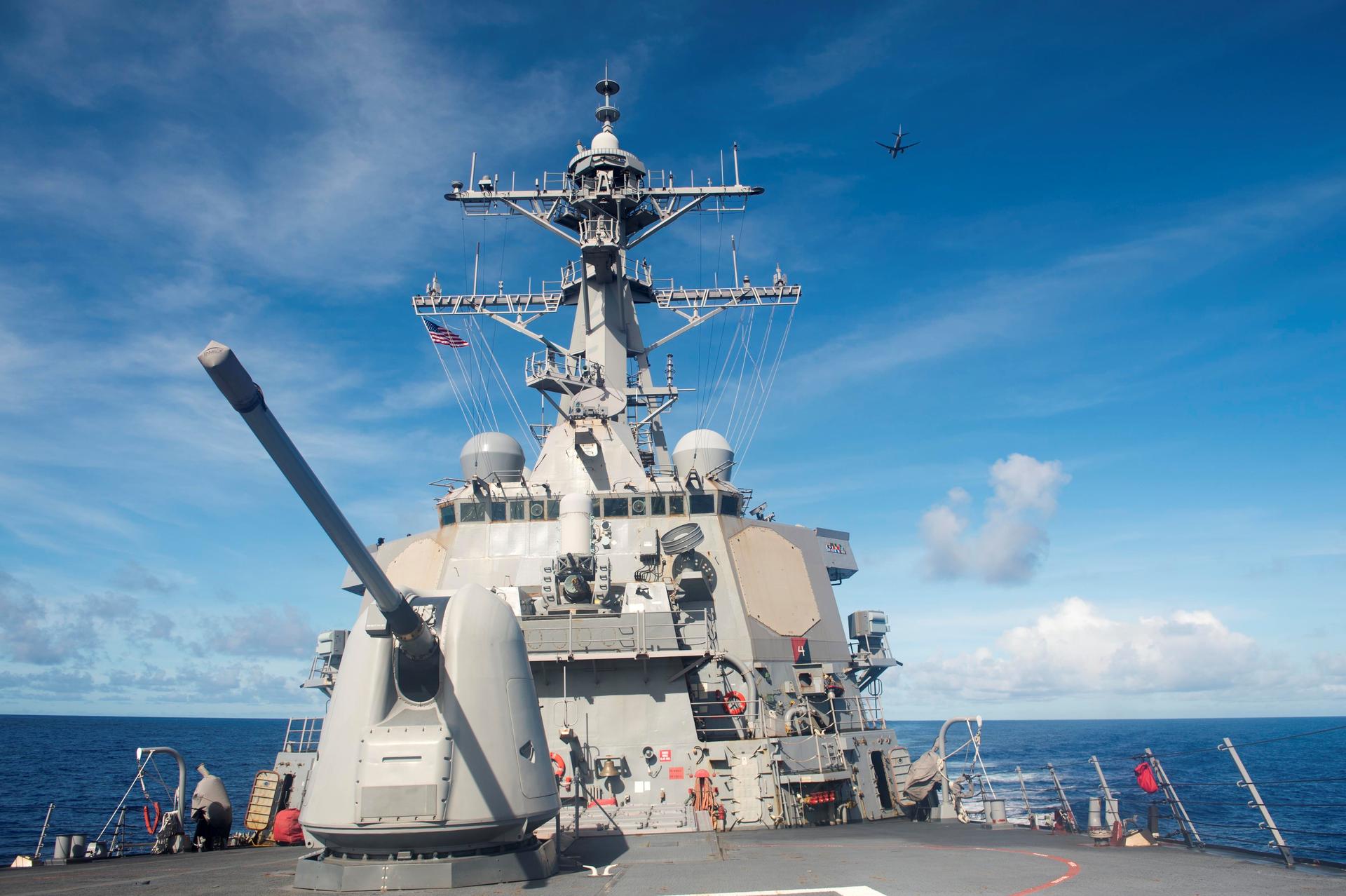
Hans Kristensen, director of the Nuclear Information Project of the Washington-based Federation of American Scientists, said he had yet to see hard intelligence suggesting China had placed fully armed ballistic missiles on its submarines at sea, despite the intense activity. Just because the submarines exist, he said, “that doesn’t mean that they have the weapons aboard the vessels.”
While acknowledging that China has significantly enhanced its nuclear deterrence, the Pentagon isn’t convinced that Chinese subs are yet conducting around-the-clock patrols. In a January report, the Pentagon’s Defense Intelligence Agency said the Chinese navy would need a minimum of five Jin-class submarines to maintain a continuous nuclear deterrence at sea. China now has four.
Undersea duels
A fleet of nuclear missile submarines hidden in the vast expanses of the ocean would help offset Beijing’s nuclear shortcomings, say Chinese and Western strategists.
Chinese naval designers and nuclear technicians have been working to build a force of nuclear missile submarines since the late 1950s. A single vessel was launched in the 1980s, but it was never fully operational. This submarine served as a test bed as Chinese technicians and designers struggled to overcome problems with nuclear propulsion technology, missiles and excessive noise that would have made the vessels easier for an adversary to detect and target.
To maximize its second-strike capability, China’s missile subs would need to be stealthy enough to go undetected as they sail to their patrol areas in the open ocean. US and other foreign naval analysts say the Jin-class submarines are a sharp improvement over China’s earlier efforts, but they remain less stealthy than their US, Russian, French and British counterparts.
The 12,000-ton Jin-class submarines are stationed on the southern coast of China’s Hainan Island, close to deep water channels leading into and out of the South China Sea. The geography of China’s coastal waters has forced Beijing to base its missile submarines in this area, astride one of the world’s most important shipping lanes.
In the north, the Yellow Sea is too shallow to conceal big, ballistic missile submarines. The East China Sea is deeper but it’s confined by the Korean Peninsula, Japan’s island chain and Taiwan.
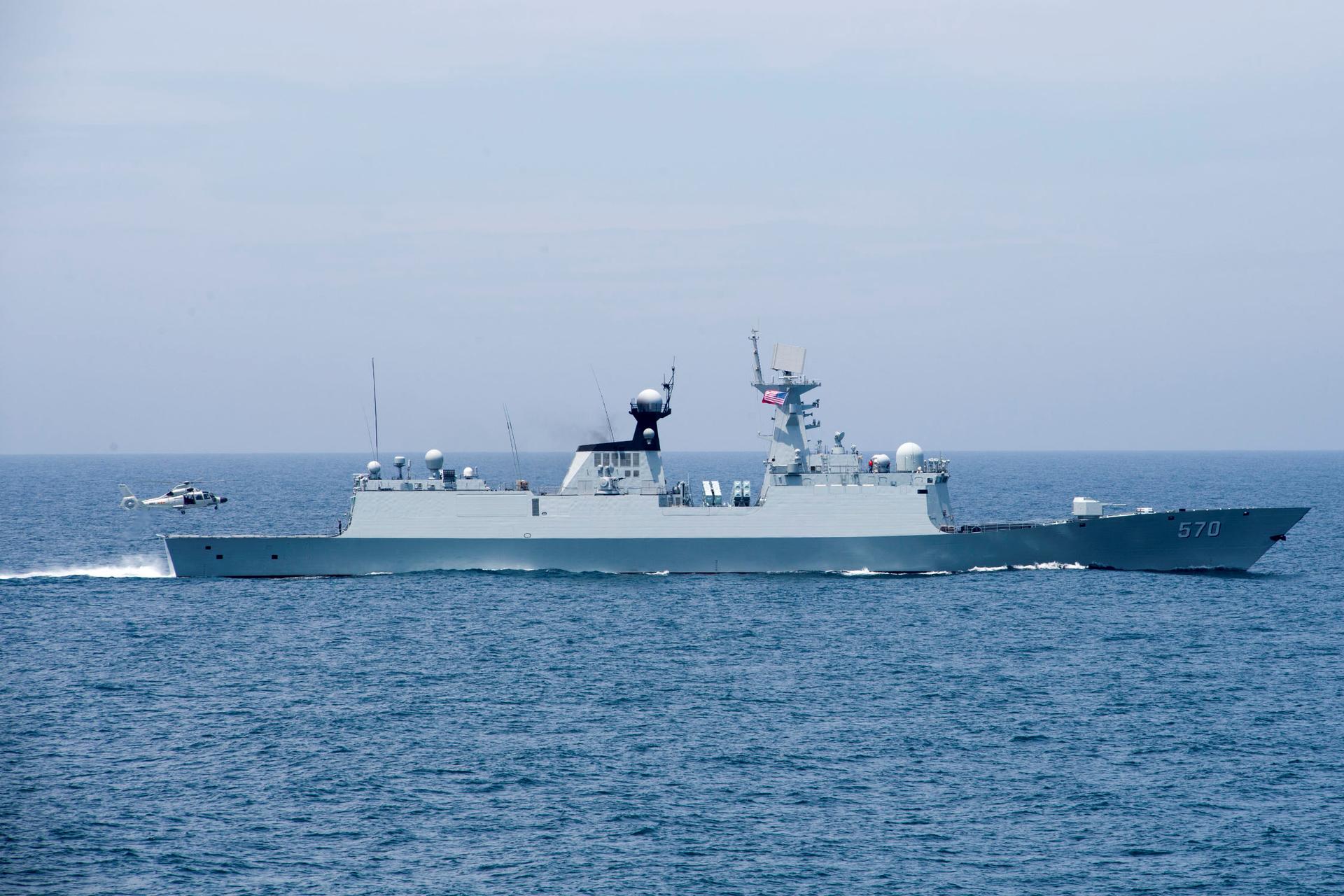
And Japanese and US forces can deploy advanced antisubmarine warfare ships and aircraft based in Japan to closely monitor these waters and the channels that pass out into the Western Pacific, where the submarines are ultimately headed. The Chinese need to reach these waters to be in a position to fire on the United States.
The South China Sea, by contrast, is much bigger and in parts deeper, making it more suitable for concealed submarine operations, according to Western submariners with extensive experience of patrolling in this area.
China would need to get its submarines out of Hainan, past surveillance and into seas east of the Philippines for their missiles to be in striking range of the United States. This is a key reason why China has gone to such lengths to reclaim and fortify islands and reefs in the South China Sea that are expanding Beijing’s control over this area, according to Western submariners and military attaches.
The sub fleet’s vulnerability to detection also explains China’s extreme sensitivity to the surveillance operations of the United States and its allies in these waters. A Chinese destroyer sailed within 45 meters of the American destroyer USS Decatur in late September, as the American warship patrolled in the Spratlys, a highly contested island chain where China has expanded its foothold in recent years. It was the latest in a series of close encounters in the past decade.
China now appears to be on guard against foreign subs attempting to detect and shadow its ballistic missile fleet. As China’s Jin-class vessels put to sea, they appear to be flanked by protective screens of surface warships and aircraft on station to track foreign submarines, according to military officers and analysts familiar with allied surveillance of the Chinese coast.
Related: US and Chinese warships came perilously close to collision
Serving and former senior naval officers also point to the extensive, frequent deployments of the Chinese navy’s latest Type 056A corvettes into key waters south of Japan and east of the Philippines. The Type 056A is China’s most advanced submarine hunter. It is able to tow sonar arrays and other listening equipment deep beneath the surface to detect enemy submarines – advanced technology that China did not have just five years ago.
China has also installed an array of sensors, antennas and satellite communications installations on islands in the Spratlys, according to the International Institute for Strategic Studies. The PLA is tracking the foreign undersea hunters from the air, too. It has formed a squadron of Y-8GX6 aircraft on Hainan with the ability to comb vast areas of the sea surface for magnetic anomalies. The turboprop planes have already been seen landing on Woody Island, China’s key offshore holding in the South China Sea. These patrols are not the infrequent exercises of the past, but now near-constant deployments, shadowing foreign warships as well.
“We’re looking at them looking for us,” said one Western military attache.
Furtive force
The submarine base near Sanya is now under direct control of the Central Military Commission, the top military decision-making body, chaired by Xi Jinping himself. The new communications installations in the South China Sea have helped knit together the new command structure, allowing tighter control from Beijing, right down to individual vessels.
In 2017, Beijing appointed a veteran submariner, Vice Admiral Yuan Yubai, to head the Southern Theater Command, which is responsible for the South China Sea. His promotion was a clear indication of the importance China attaches to supporting nuclear sub operations, according to Chinese naval experts. Yuan is the first naval officer to head a command of this type, a promotion that’s part of a sweeping overhaul of the military structure by Xi Jinping.
Commercial satellite images of the submarine base give insight into the furtive force stationed there. They appear to show missile submarines regularly tied up alongside long piers in the harbor. Satellite images from Google Earth in June last year show what appear to be three Jin-class missile submarines at the base.
The vessels have a distinctive shape, with a hump-like structure that houses the missile tubes behind the sail, the vertical structure that rises from a submarine’s hull. Clearly visible in the images: a partially submerged entrance to what appear to be underground submarine pens, beneath a hill next to the harbor.
Construction at the base near Sanya also points to the PLA’s ability to stealthily arm submarine-launched missiles with nuclear warheads.
Western intelligence analysts familiar with satellite imagery of the area say a covered railway has been completed that runs into a hillside bunker – the suspected warhead arsenal. The railway, in turn, is linked by tunnels to the pens built for the submarines. This, they say, means the missiles can be armed and loaded on the submarines – without detection.
Greg Torode and David Lague of Reuters reported from Hong Kong.
